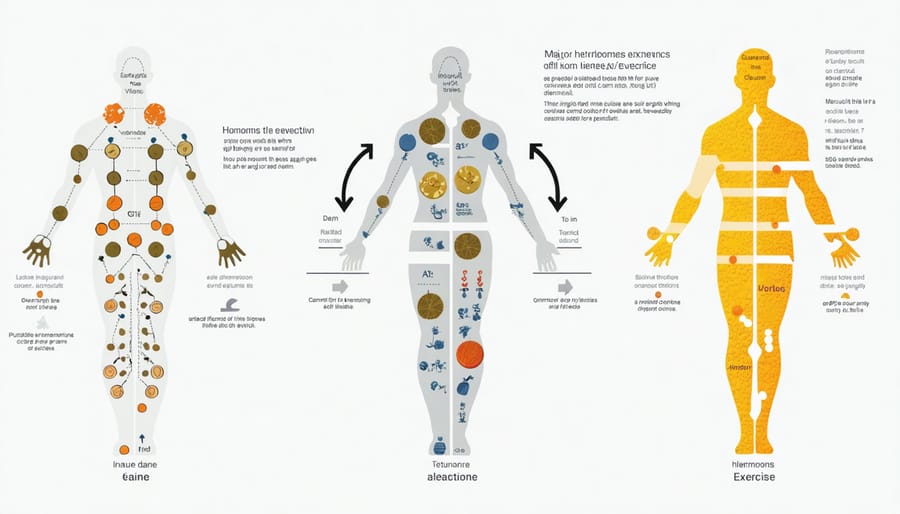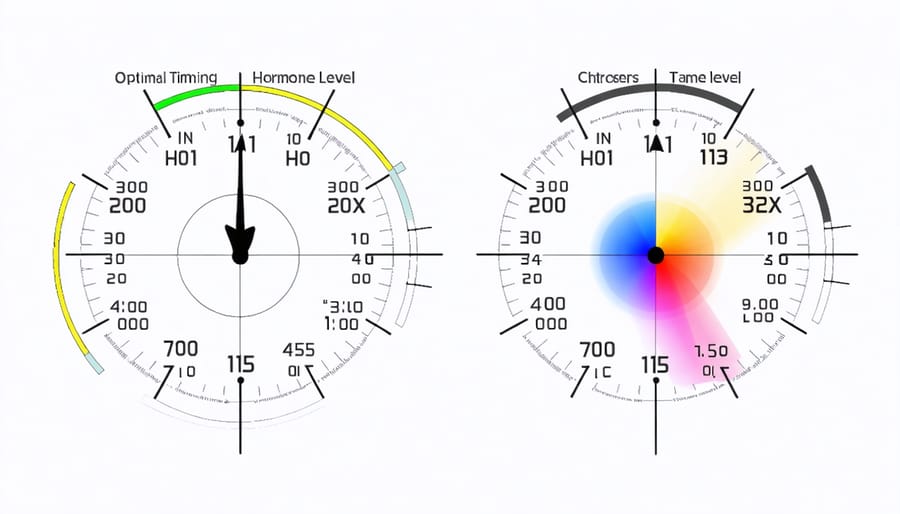Exercise profoundly impacts your body’s hormone regulation, orchestrating a complex symphony of chemical messengers that influence everything from mood to metabolism. Regular physical activity helps balance your hormones naturally, triggering the release of beneficial compounds like endorphins, growth hormone, and testosterone while regulating stress hormones such as cortisol.
The relationship between exercise and hormones works both ways: your workout routine can optimize hormone production, while your hormones determine how effectively your body responds to exercise. Whether you’re lifting weights, running, or practicing yoga, each movement sends signals throughout your endocrine system, activating hormone-producing glands and fine-tuning their output.
Understanding this connection empowers you to design workouts that target specific hormonal benefits – from boosting energy and improving sleep to building muscle and reducing stress. Recent research reveals that even modest amounts of physical activity can create significant positive changes in hormonal health, making exercise one of the most powerful tools available for maintaining optimal hormone balance.
The Science Behind Exercise and Hormone Balance

Key Hormones Affected by Exercise
When you exercise, your body experiences significant exercise-induced hormone changes that affect your overall health and fitness. Four key hormones play essential roles in this process: testosterone, cortisol, growth hormone, and insulin.
Testosterone, often associated with muscle growth and strength, increases during exercise in both men and women. Regular physical activity, especially strength training, can help maintain healthy testosterone levels, which supports muscle development, bone density, and energy levels.
Cortisol, commonly known as the stress hormone, naturally rises during exercise but typically returns to normal levels afterward. While short-term increases are beneficial for energy production and inflammation control, maintaining balanced cortisol levels through proper rest and recovery is crucial.
Growth hormone production surges during intense exercise, particularly during strength training and high-intensity interval workouts. This hormone helps build and repair tissues, supports fat metabolism, and contributes to muscle growth and recovery.
Exercise also significantly impacts insulin, the hormone responsible for blood sugar regulation. Regular physical activity improves insulin sensitivity, helping your body use glucose more effectively. This enhanced insulin function is particularly beneficial for managing weight and reducing the risk of type 2 diabetes.
Understanding these hormonal responses can help you optimize your workout routine. For example, mixing different types of exercise throughout the week and allowing adequate recovery time can help maintain a healthy hormone balance while maximizing the benefits of your fitness efforts.
Exercise Types and Their Hormonal Impact
Strength Training Benefits
Strength training stands out as a powerful way to optimize your body’s hormone production and regulation. When you engage in resistance exercises, such as weightlifting or bodyweight exercises, your body responds by releasing important hormones that support muscle growth and overall health.
One of the most significant benefits is the increase in growth hormone and testosterone production. These anabolic hormones play crucial roles in building and maintaining muscle mass, supporting bone density, and regulating metabolism. Even moderate-intensity resistance training can trigger these beneficial hormonal responses, making it accessible for people of all fitness levels.
The hormonal benefits extend beyond just muscle growth. Regular strength training helps regulate insulin sensitivity, which is essential for maintaining healthy blood sugar levels and reducing the risk of type 2 diabetes. It also promotes the release of endorphins, your body’s natural mood enhancers, helping to reduce stress and anxiety.
To maximize these hormonal benefits, aim to include compound exercises that work multiple muscle groups simultaneously, such as squats, deadlifts, and push-ups. Experts recommend performing strength training exercises at least two to three times per week, allowing adequate rest between sessions for proper hormone regulation and recovery.
Remember that consistency is key – the hormonal benefits of strength training accumulate over time, contributing to better overall health and wellness.

Cardiovascular Exercise Effects
Regular cardiovascular exercise has a significant impact on our body’s hormone production and regulation, particularly when it comes to stress hormones and feel-good chemicals. During endurance activities like running, cycling, or swimming, your body initially releases cortisol, the primary stress hormone. However, as you maintain a consistent exercise routine, your body becomes more efficient at managing these stress responses.
One of the most notable benefits of cardio exercise is the release of endorphins, often referred to as the body’s natural mood elevators. These powerful hormones help reduce pain perception and create the famous “runner’s high” – a feeling of euphoria and reduced anxiety that many people experience after sustained aerobic activity.
Regular cardiovascular training also helps regulate adrenaline and noradrenaline levels. While these hormones spike during exercise, consistent training helps your body become better at maintaining balanced levels throughout the day. This improved hormone regulation can lead to better stress management, more stable energy levels, and improved sleep quality.
The hormone-balancing effects of cardio are most pronounced when you engage in moderate-intensity exercise for at least 30 minutes, three to five times per week. This could include brisk walking, jogging, swimming, or any other activity that elevates your heart rate while still allowing you to maintain a conversation.
For optimal hormone regulation, it’s important to avoid overtraining, which can lead to excessive cortisol production and hormone imbalance. Listen to your body and allow adequate rest between sessions.

Timing Your Workouts for Optimal Hormone Response
The timing of your workouts can significantly influence your body’s hormonal response, helping you maximize the benefits of exercise. Morning workouts, particularly between 6:00 AM and 8:00 AM, can take advantage of naturally higher cortisol levels, which can help you feel more energized and alert during exercise. This timing also aligns with your body’s circadian rhythm, potentially leading to better fat burning and improved insulin sensitivity throughout the day.
For muscle growth and strength gains, late afternoon workouts (between 3:00 PM and 6:00 PM) often prove most effective. During this time, your body temperature peaks, muscle strength reaches its daily high, and testosterone levels are optimal for building and maintaining muscle mass. This window also typically shows lower injury risks due to improved muscle flexibility and coordination.
However, evening workouts aren’t off the table. While some worry about exercise disrupting sleep, research shows that moderate exercise up to two hours before bedtime can actually promote better sleep quality for most people. The key is to avoid high-intensity workouts too close to bedtime, as these may delay the natural drop in body temperature needed for quality sleep.
The most important factor isn’t necessarily the specific time you exercise, but rather the consistency of your workout schedule. Your body adapts to regular exercise patterns, optimizing hormone release based on your routine. Choose a time that fits your daily schedule and energy levels, making it easier to maintain a long-term exercise habit. Remember to listen to your body and adjust your workout timing if you notice changes in your energy, performance, or sleep quality.
Practical Tips for Hormone-Optimizing Exercise
To maximize hormonal benefits through exercise, aim for a balanced routine that includes both strength training and cardiovascular activities. Schedule your most intense workouts between 7 AM and 10 AM when cortisol levels naturally peak. Perform strength training 2-3 times per week, focusing on compound exercises like squats, deadlifts, and push-ups to boost growth hormone and testosterone production.
Include 20-30 minutes of moderate-intensity cardio on most days to regulate insulin sensitivity and support stress hormone balance. Remember to allow adequate recovery time between workouts – at least one full rest day per week – to prevent excessive cortisol elevation.
Keep exercise sessions between 30-60 minutes to maintain optimal hormone response. Longer sessions may increase stress hormones unnecessarily. Complement your exercise routine with proper dietary choices for hormone balance and quality sleep.
For beginners, start with walking and basic bodyweight exercises, gradually increasing intensity as fitness improves. Listen to your body and adjust workout intensity based on energy levels and recovery capacity. Stay consistent with your routine while avoiding overtraining to maintain healthy hormone regulation.
Regular exercise plays a vital role in maintaining healthy hormone levels, affecting everything from stress management to metabolism. By incorporating a mix of cardio and strength training, keeping workouts moderate but consistent, and allowing proper recovery time, you can optimize your body’s hormone regulation. Remember that small, sustainable changes to your exercise routine can lead to significant improvements in your overall hormonal health. Start today by making mindful choices about your workout intensity and frequency to support your body’s natural hormone balance.

